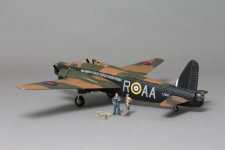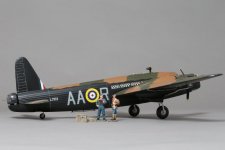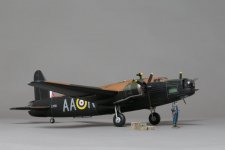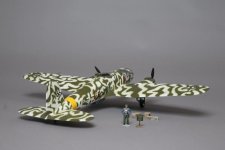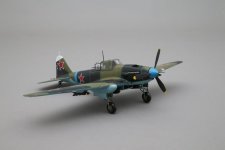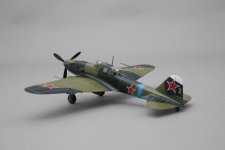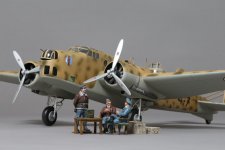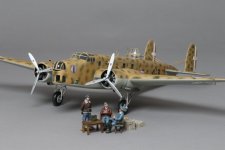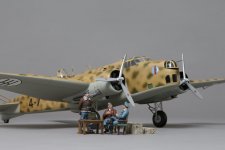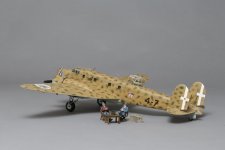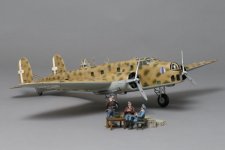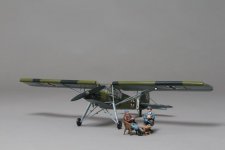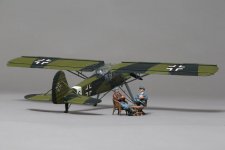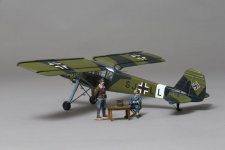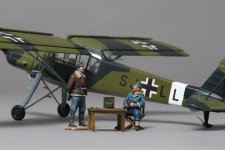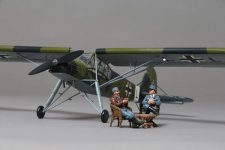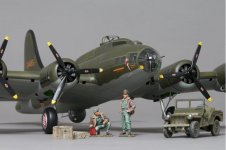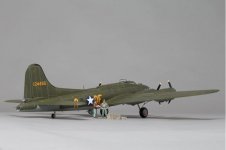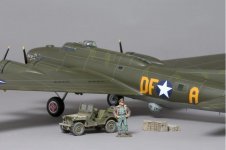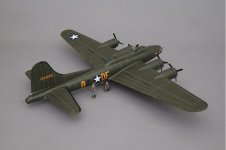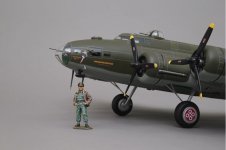Our second aircraft WOW 202; The Vickers Wellington was a British twin-engined, long-range medium bomber. It was designed during the mid-1930s at Brooklands in Weybridge Surrey, led by Vickers-Armstrongs’ chief designer Rex Pierson. A key feature of the aircraft is its geodetic airframe fuselage structure, which was principally designed by Barnes Wallis and is faithfully captured on our model should you peer through the fuselage windows. This of course made carving the Wellington an extremely delicate operation but I think we have done Barnes Wallis and his team proud. Development had been started in response to an Air Ministry Specification, which was issued in the middle of 1932. This specification called for a twin-engined day bomber capable of delivering higher performance than any previous design.
The Wellington was used as a night bomber in the early years of the Second World War, performing as one of the principal bombers used by Bomber Command, it normally carried a 6 man crew. It holds the distinction of having been the only British bomber that was produced for the duration of the war, and of having been produced in a greater quantity than any other British-built bomber. The aircraft came to be largely regarded as being an advanced design for its era and proved to have considerable merit during its flight trials. In October 1943, as a propaganda and morale-boosting exercise, workers at Broughton gave up their weekend to build Wellington number LN514 rushed by the clock. The bomber was assembled in 23 hours 50 minutes, and took off after 24 hours 48 minutes, beating the record of 48 hours set by a factory in California. Each Wellington was usually built within 60 hours.
A total of 180 Wellington Mk I aircraft were built; 150 for the RAF and 30 for the Royal New Zealand Air Force (RNZAF) (which were transferred to the RAF on the outbreak of war and used by 75 Squadron).
Aptly enough our 1/32 scale model is one of the most famous NZ aircraft flown by James Allen Ward Victoria Cross recipient, read below the details of his citation and his death defying wing crawl which earned him the highest British military award:
"The KING has been graciously pleased to confer the VICTORIA CROSS on the undermentioned non-commissioned officer in recognition of most conspicuous bravery:-
NZ401793 Sergeant Pilot James Allen Ward
On the night of 7 July 1941, Sergeant Ward was second pilot of a Wellington bomber returning from an attack on Munster. While flying over the Zuider Zee at 13,000 feet his aircraft was attacked from beneath by a German ME110, which secured hits with cannon-shell and incendiary bullets. The rear gunner was wounded in the foot but delivered a burst of fire sending the enemy fighter down, apparently out of control. Fire then broke out in the Wellington's near-starboard engine and, fed by petrol from a split pipe, quickly gained an alarming hold and threatened to spread to the entire wing. The crew forced a hole in the fuselage and made strenuous efforts to reduce the fire with extinguishers, and even coffee from their flasks, without success. They were then warned to be ready to abandon the aircraft. As a last resort Sergeant Ward volunteered to make an attempt to smother the fire with an engine cover which happened to be in use as a cushion. At first he proposed discarding his parachute to reduce wind resistance, but was finally persuaded to take it. A rope from the aircraft dingy was tied to him, though this was of little help and might have become a danger had he been blown off the aircraft.
With the help of his navigator he then climbed through the narrow astrodome and put on his parachute. The bomber was flying at a reduced speed but the wind pressure must have been sufficient to render the operation one of extreme difficulty. Breaking the fabric to make hand and foot holds where necessary and also taking advantage of existing holes in the fabric, Sergeant Ward succeeded in descending three feet to the wing and proceeding another three feet to a position behind the engine, despite the slipstream from the airscrew which nearly blew him off the wing. Lying in this precarious position he smothered the fire in the wing fabric and tried to push the engine cover into the hole in the wing and on the leaking pipe from which the fire came. As soon as he had removed his hand, however, a terrific wind blew the cover out and when he tried again it was lost. Tired as he was, he was able, with the navigator's assistance, to make a successful but perilous journey back into the aircraft. There was now no danger of fire spreading from the petrol pipe as there was no fabric left near it and in due course it burned itself out. When the aircraft was nearly home, some petrol which had collected in the wing blazed up furiously but died down quite suddenly. A safe landing was made despite the damage sustained to the aircraft. The flight home had been made possible by the gallantry of Sergeant Ward in extinguishing the fire on the wing in circumstances of the greatest difficulty and at the risk of his life"
A limited edition of 5 of these models are available worldwide for immediate delivery today priced at $1200 plus $200 postage. Once again any customers ordering and paying a $250 deposit during the month of September will receive a 10% discount equal to $140 off their final invoice. No more Wellington's are planned after this batch please note.

